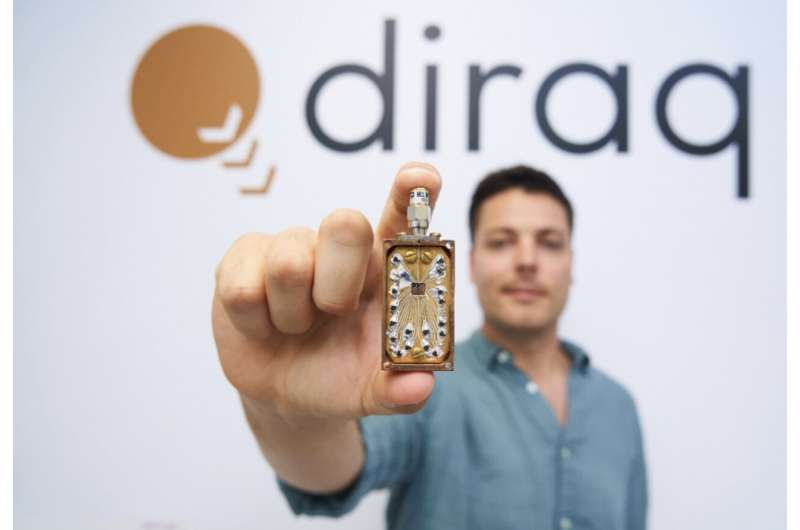
October 14, 2024 by Ingrid Fadelli , Phys.org
Collected at: https://phys.org/news/2024-10-explores-physical-errors-qubit-processor.html
To achieve remarkable performances, quantum computing systems based on multiple qubits must attain high-fidelity entanglement between their underlying qubits. Past studies have shown that solid-state quantum platforms—quantum computing systems based on solid materials—are highly prone to errors, which can adversely impact the coherence between qubits and their overall performance.
Researchers at Diraq, a Sydney-based quantum hardware technology company, and UNSW recently set out to investigate the errors emerging in a spin qubit processor composed of high-fidelity two-qubit gates in silicon quantum dots.
Their findings, published in Nature Physics, provide new insight into the possibilities and challenges associated with the up-scaling of silicon spin-based qubits.
“The 21st century has revolved around computerization thanks to the semiconducting silicon chip,” Andrew Dzurak and Tuomo Tanttu, co-authors of the paper, told Phys.org.
“The humble silicon chip is critical to the digitalization and interconnectivity of our daily lives—from the phones we use, the computers we rely on and the systems we operate for accessing information, sharing data, and effectively managing the infrastructure and decision-making tools needed for interconnected modern thriving economies.
“This demand has underpinned the growth of the complementary metal-oxide semiconductor (CMOS) manufacturing industry.”
In recent years, some engineers and quantum physicists have been exploring the possibility of developing quantum technologies using well-established silicon-based transistors. This is because the processes for manufacturing these transistors are well-established and highly controlled.
“State-of-the-art fabrication processes are central to the Diraq vision of building the world’s first fault tolerant quantum computer based on silicon quantum dots,” said Dzurak, CEO and Founder of Diraq. “Our foundational IP is in the design and operation of silicon spin qubits compatible with CMOS foundry manufacturing.”
Dzurak, Tanttu and their colleagues at Diraq have been exploring ways to leverage lithographic techniques used to manufacture silicon transistors to fabricate quantum technologies. The researchers have recently been specifically exploring the potential of advanced techniques for encoding qubits in semiconductor spin carriers that could be manufactured and integrated on a large scale.

“Quantum computation requires many qubits that can be coherently controlled and coupled to each other,” said Dzurak. “We set ourselves the challenge to understand whether it is possible to execute high-fidelity (above 99%) entangling gates between qubits in the same silicon platform that is used for silicon transistors. The research expanded to also understand what noise sources degrade the fidelity of the entangling gate.”
By exploring the physical origin of errors in silicon-based quantum processors, Dzurak, Tanttu and their colleagues plan to contribute to the development of quantum computers built on widely available materials. As part of their study, they used three key diagnostic techniques to benchmark and characterize quantum states and logic gates in a silicon-based spin qubit device.
“We wanted a comprehensive methodology, so we chose three different robust techniques to support our investigation into the control and measurement of sustained performance,” explained Tanttu. “The three measurement techniques we used are Interleaved Randomized Benchmarking (IRB), Gate Set Tomography (GST) and Fast Bayesian Tomography (FBT).”
All of the techniques employed by the researchers entail running a set of specific logical circuits in a quantum processor. By applying them to their processor, they gathered information about the physics underlying its functioning and thus any errors produced.
“These diagnostic tools are essential to the development of quantum devices as they are critical to improving system reliability and quantum logic operations, also known as logic gates,” said Tanttu.
“For example, with GST, the findings inform how to prevent errors instead of correcting them. Both tomography methods yielded a detailed picture on the noise channels. In contrast, the more traditional IRB method yielded a single fidelity number with no additional physical information.”
Dzurak, Tanttu and colleagues also identified a promising method for extracting rich information from data connected using IRB. Specifically, they reanalyzed the IRB data by running an FBT analysis on the exact same dataset.

“This yielded information on the noise channels and how they evolved over time,” explained Tanttu. “In summary, the combination of these different techniques allowed us to build a more complete physical picture of our system and enabled us to better benchmark the performance of our qubit.”
The tests carried out by this research team led to two important findings. First, they demonstrated the possibility of attaining high operational fidelities of above 99% for the entangling gates in their platform.
Second, they were able to identify sources of noise in their entangling gates. This in turn allowed them to devise strategies to improve the fidelity of their gates.
“Our results do imply the viability of using the silicon transistor technology as the core building block for making future utility-scale quantum computers,” said Dzurak. “In practice, this also means that we can focus more on scaling up the platform.”
The team at Diraq is now working on further improving and testing their spin qubit processor. For instance, they are planning to repeat their experiment beyond the university laboratory devices, using spin processors manufactured in a semiconductor foundry.
“Additionally, we think there is strong merit in exploring whether the understanding of the underlying errors can be utilized to further improve the fidelity of the operation with enhanced materials or different control methods,” added Dzurak.
“With our operational fidelities in close alignment to other solid-state platforms, what we are looking forward to now are further advances, in particular by increasing the number of qubits in a single chip.”
More information: Tuomo Tanttu et al, Assessment of the errors of high-fidelity two-qubit gates in silicon quantum dots, Nature Physics (2024). DOI: 10.1038/s41567-024-02614-w
Journal information: Nature Physics

Leave a Reply